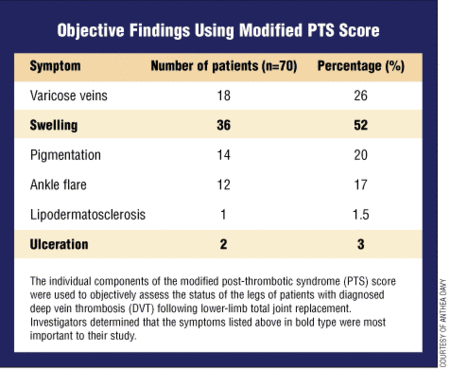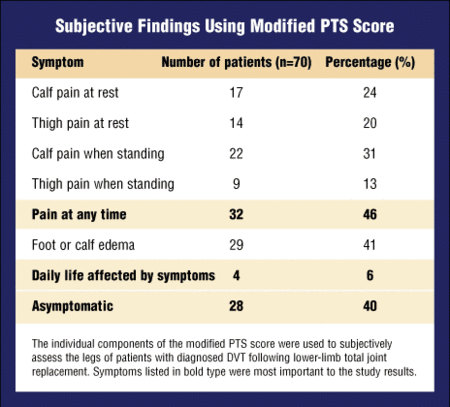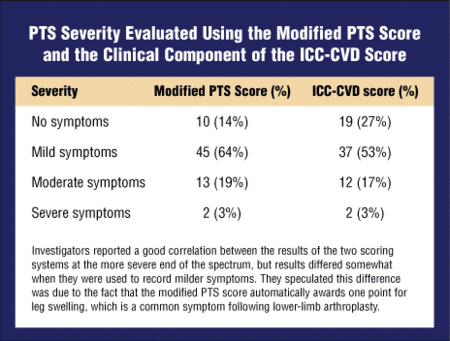DVT treatment after joint replacement reduces risk of post-thrombotic syndrome
Forty percent of patients treated for post-joint replacement DVT did not complain of symptoms.
 WELWYN GARDEN CITY,
England — There was a 3% incidence of post-thrombotic syndrome following
lower-limb joint replacement when deep vein thrombosis was detected and treated
early in a recent large-scale prospective study.
WELWYN GARDEN CITY,
England — There was a 3% incidence of post-thrombotic syndrome following
lower-limb joint replacement when deep vein thrombosis was detected and treated
early in a recent large-scale prospective study.
Post-thrombotic syndrome (PTS), one of the late sequelae of deep vein thrombosis (DVT), is characterized by chronic venous insufficiency and skin changes, including varicose veins, edema, exema, pigmentation and ulceration, said Anthea Davy, MRCS, orthopaedic registrar at Queen Elizabeth II Hospital, here.
Davy and her co-investigators studied the incidence of PTS in 526 patients who underwent elective total hip or knee replacement and had a venogram 10 days postoperatively. Patients with a diagnosed DVT subsequently received treatment with warfarin for three to six months. “Severe, symptomatic PTS is rare following early detection and treatment of DVT after total hip or knee replacement,” Davy said. She presented results of the study during the British Orthopaedic Association Annual Congress in Cardiff, Wales.

Venography detects DVT
Patients studied had a surveillance venogram after 10 postoperative days. Venogram results showed that 93 patients had a DVT. Those with identified DVTs were treated with warfarin for three to six months postoperatively and were followed up for at least seven years. The investigators observed 70 surviving patients, a 97% follow-up.
Clinical assessment of DVT patients at follow-up included a physical examination and questionnaire. Two classification systems were used: the modified PTS score and the clinical component of the International Consensus Committee on Chronic Venous Disease (ICC-CVD) classification.
With the modified PTS score, patients were given points for their symptoms, and points were weighted according to the importance of the corresponding symptom, she said. The points were then totaled to produce an overall PTS score, which indicated whether the patient had mild, moderate or severe PTS. The ICC-CVD score looked at symptoms and signs in just the treated limb and classified them from 1, which was low severity, to 6. Investigators then rated the limb as having mild, moderate or severe PTS disease.

According to the modified PTS score, 14% of patients were symptom-free. Mild symptoms were detected in 64% of patients. Approximately 20% of patients had moderate symptoms and 3% of patients exhibited severe symptoms. According to the ICC-CVD score, 17% of patients had moderate symptoms, and the proportion of patients having mild or no symptoms varied slightly from that reported with the modified PTS score.
“Looking at both classification systems, there is a quite good correlation between the scoring systems at the more severe end of the spectrum, but in the low and mild side there is significant difference between the two scoring systems,” Davy said. These low-end differences possibly resulted from the potential that the PTS score has for overgrading symptom severity, she noted.
Regarding subjective findings, 46% of patients complained of pain at some time and 41% of patients complained of foot or calf edema. Only 6% of patients said their lives were affected by their symptoms and 40% of patients did not complain of symptoms. “If the DVT is diagnosed early and treated adequately, the risk of severe PTS is actually quite low,” she said.

For your information:
- Davy A, Goldberg A, Hunter JB, et al. The incidence of post-phlebitic syndrome following hip and knee arthroplasty complicated by proven deep vein thrombosis: a prospective study. Presented at the British Orthopaedic Association Annual Congress. Sept. 18-20, 2002. Cardiff, Wales.
